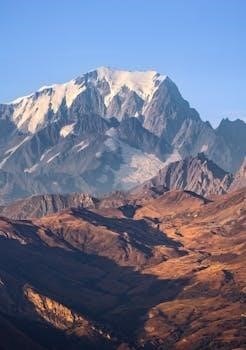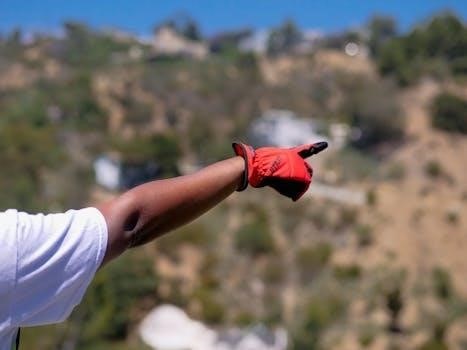Self-Guided Tour du Mont Blanc⁚ An Overview
Embarking on a self-guided Tour du Mont Blanc offers incredible freedom, allowing hikers to explore the iconic trail at their own pace. This option provides flexibility in choosing routes, durations, and accommodation. With proper planning, it’s a rewarding experience.
What is the Tour du Mont Blanc?
The Tour du Mont Blanc (TMB) is a renowned long-distance hiking trail that encircles the Mont Blanc massif, traversing through France, Italy, and Switzerland. This iconic trek spans approximately 170 kilometers, offering breathtaking views of some of the most spectacular alpine landscapes in Europe. Hikers on the TMB experience a diverse range of terrain, from lush valleys to challenging mountain passes, all while being surrounded by towering peaks and glaciers. The TMB is not just a hike; it’s an immersive journey through different cultures and natural beauty. It’s known for its well-maintained trails and a network of mountain refuges, making it accessible to hikers of various skill levels. The trail is a popular choice for both seasoned trekkers and those new to multi-day hiking adventures, offering a unique opportunity to connect with the mountains and oneself. The TMB offers unforgettable memories.
Self-Guided vs. Guided Tours
When considering a Tour du Mont Blanc adventure, a key decision is whether to opt for a self-guided or a guided tour. Self-guided tours offer the freedom to set your own pace, choose your itinerary, and enjoy a sense of independence. You are responsible for navigation, accommodation booking, and daily logistics. This option suits experienced hikers comfortable with planning and managing their trek. Guided tours, on the other hand, provide the expertise of a leader, pre-booked accommodations, and often included meals. This choice is beneficial for those seeking convenience and support. Guides provide valuable insights into the region and its culture. Self-guided tours offer more flexibility, while guided tours offer less stress and more structure. The choice depends on your comfort level and desired experience. Both offer unique ways to experience the TMB. Consider your priorities and preferences to determine the best fit.

Planning Your Self-Guided TMB Trek
Careful planning is crucial for a successful self-guided TMB trek. This involves selecting the right maps, choosing your itinerary, and determining the optimal time to hike. Thorough preparation ensures a safer and more enjoyable experience.
Essential Maps and Navigation
Navigating the Tour du Mont Blanc independently requires reliable maps and navigation skills. Detailed topographic maps, specifically designed for the TMB, are essential. These maps should clearly show the trail, elevation changes, and potential alternative routes. It’s advisable to carry both paper maps and a digital version on your smartphone or GPS device. Familiarize yourself with map reading techniques before your trek. A compass is a crucial backup for digital tools. Online mapping resources can be valuable for pre-trip planning, offering route details and variants that might not be obvious on standard maps. Consider downloading offline maps to your device to ensure navigation even without a cell signal. Learning to use a GPS device can also be beneficial for accurate tracking and route planning. Having backup power is also advisable. Remember, being able to navigate effectively is important for safety and a smooth trek.
Choosing Your Itinerary Duration
The duration of your self-guided Tour du Mont Blanc trek is a crucial decision, influencing the pace and overall experience. Typically, the full circuit takes around 10 to 12 days, but shorter options are popular for those with less time. Many choose 6, 7, or 8-day itineraries, focusing on specific sections of the trail. Consider your fitness level and hiking experience when selecting the length. A shorter itinerary often means longer daily distances. Longer trips allow for a more relaxed pace, giving more time to enjoy views and explore villages. Factors such as the amount of ascents and descents in each stage will impact the daily distance that is feasible. It’s also possible to create a custom itinerary and focus on the most iconic parts. For example, some may prefer to hike from Chamonix to Zermatt, or between other iconic locations. Careful planning is important when deciding the length of a trip.
Best Time to Hike the TMB
The ideal time to hike the Tour du Mont Blanc is crucial for a comfortable and enjoyable experience. The main hiking season runs from mid-June to mid-September. During this period, the weather is generally favorable, with warmer temperatures and less chance of snow. July and August are the busiest months, offering warm weather but with more crowded trails and booked accommodations. Late June and early September often provide a good balance, with fewer crowds and pleasant hiking conditions. Hiking outside of this peak season can be challenging due to potential snow on high passes, and many huts and accommodations may be closed. Always check the weather forecast and trail conditions before your departure, irrespective of the chosen time. If you plan on tackling the trail during peak months, it is highly recommended to book your accommodations and transport well in advance. This will guarantee availability.

Typical Self-Guided Itineraries
Self-guided TMB treks offer diverse route options. From Les Houches to Refuge Miage, or Refuge Bonhomme to Val Veny, to Chamonix to Zermatt, each itinerary provides unique scenery and challenges, catering to different preferences and skill levels.

Example Itinerary⁚ Les Houches to Refuge Miage
This initial segment of a self-guided Tour du Mont Blanc typically begins in the charming village of Les Houches, a popular starting point for many hikers. The trail ascends gradually, offering panoramic views of the surrounding mountains and valleys as you progress. The route meanders through forests, across meadows, and past small streams, providing a diverse landscape to enjoy. This section is often considered a gentler introduction to the TMB, allowing hikers to acclimatize to the altitude and the trail conditions. The destination, Refuge Miage, is a beautiful mountain hut nestled in a scenic valley, where you can rest and enjoy a well-deserved meal. This day’s hike usually takes around 5 to 7 hours, depending on individual pace and fitness levels. It’s crucial to have a good map and be aware of trail markings. This stage sets the tone for the incredible journey ahead on the Tour du Mont Blanc.
Example Itinerary⁚ Refuge Bonhomme to Val Veny
This stage of the self-guided Tour du Mont Blanc takes you from the high-altitude Refuge Bonhomme down into the beautiful Val Veny. Leaving the refuge, the trail often traverses exposed ridges with stunning panoramic views of the Mont Blanc massif. The descent can be steep in places, requiring careful footing; Hikers will pass through varied terrain, from rocky paths to alpine meadows, witnessing the dramatic changes in landscape. The route might involve crossing small streams and navigating through areas with loose scree. As you descend into Val Veny, the scenery transforms, becoming more lush and verdant. The final destination is often the valley floor, where you’ll find various accommodation options. This leg of the trek typically takes around 6 to 8 hours, depending on the specific route and pace. Proper preparation and navigation skills are necessary to ensure safety and enjoyment.
Example Itinerary⁚ Chamonix to Zermatt
Embarking on a trek from Chamonix to Zermatt is an ambitious but incredibly rewarding extension to the classic Tour du Mont Blanc experience. This route takes you through some of the most breathtaking scenery in the Alps, connecting two iconic mountain destinations. It is a multi-day adventure that often involves crossing high passes and traversing varied landscapes. Hikers can expect to encounter glaciers, alpine meadows, and picturesque villages along the way. The route typically incorporates segments of the Haute Route, a well-known hiking trail. This extended itinerary requires careful planning and a good level of fitness. Accommodation options range from mountain huts to small hotels in valleys. Each day will present new challenges and stunning views as you journey from the Mont Blanc massif towards the Matterhorn. Navigation skills and the ability to handle varying weather conditions are essential for this trek. The experience is unforgettable, offering a unique perspective of the Alps.

Practical Considerations
Planning a self-guided TMB requires attention to detail, including booking accommodations, arranging transportation between trailheads, and understanding safety protocols. Familiarize yourself with emergency procedures and pack appropriately for varied weather conditions.
Accommodation Options on the Trail
The Tour du Mont Blanc offers a diverse range of accommodation options catering to different preferences and budgets. Hikers can choose from mountain refuges, charming guesthouses, and comfortable hotels. Refuges, often located in remote areas, provide dormitory-style sleeping arrangements and communal meals, fostering a sense of camaraderie among hikers. Guesthouses and hotels, typically found in villages and towns along the route, offer private rooms and more amenities, including restaurants and sometimes even spas. Booking ahead is essential, especially during peak season, as popular places fill up quickly. It’s also worth considering the location of each option in relation to your daily itinerary; some are directly on the trail, while others require a detour. Each type of accommodation offers a unique experience, from basic hiker shelters to luxurious comfort, allowing you to customize your TMB adventure based on your specific needs and desires. Choosing the right mix of accommodation can greatly impact your overall enjoyment of the trek.
Transportation and Logistics
Planning transportation and logistics is crucial for a successful self-guided Tour du Mont Blanc. The trek typically starts and ends in a town accessible by public transport, such as Chamonix. Getting to the starting point and returning home often involves flights, trains, or buses. During the trek, transportation between stages is generally done on foot, but there are options for using local buses or taxis in specific sections, especially if you need to shorten a particular leg or skip a portion of the trail. Luggage transfer services are available between accommodations for hikers who prefer not to carry all their belongings. These services are more frequent in some areas than others, so diligent planning is necessary. Additionally, understanding the local transport schedules and booking in advance, when needed, is beneficial. Navigating these logistical elements efficiently will contribute to a smoother, more enjoyable trekking experience, allowing you to focus on the natural beauty and the challenge of the TMB.
Safety and Emergency Procedures
Safety is paramount on a self-guided Tour du Mont Blanc; Before your trek, ensure you have appropriate gear, including sturdy hiking boots, weather-appropriate clothing, and navigation tools like maps and a compass or GPS. Familiarize yourself with the trail conditions and weather forecasts. Carry a first-aid kit, sufficient water, and high-energy snacks. Inform someone of your itinerary and check in regularly. Be aware of your physical limitations and avoid pushing yourself beyond your capabilities. In case of an emergency, know the local emergency numbers and rescue procedures. Many sections of the trail have limited cell service, so consider carrying a satellite communication device. Familiarize yourself with the emergency protocols of the specific regions you will be trekking through, such as France, Italy, and Switzerland. Being prepared and cautious can significantly minimize risks and ensure a safe and fulfilling adventure on the TMB. Always prioritize your well-being and don’t hesitate to seek help when needed.
